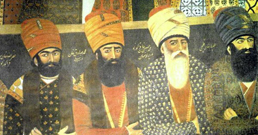Abolghassem Khan Gharagozlou was born in 1856 in Sheverin, a small village near
Abolghassem Khan’s father died relatively young, leaving him to be brought up by his grandfather Mahmoud Khan Nasser ol-Molk Farmanfarma. He noticed his grandson’s scholastic aptitude, and in 1878, requested Nasser ud-Din Shah to permit him to accompany the royal suite on his first journey to
Mahmoud Khan, as one of the Shah’s most trusted ministers, was granted his request, and Abolghassem Khan travelled to
In an austere 9 months of concentrated study, he mastered English, Latin, Greek and all the branches of mathematics, in preparation for his entrance examination to
His admission to
Balliol College was then at the height of its fame and influence under Benjamin Jowett, who had taken a particular liking to Abolghassem Khan, for he often invited him to his Sunday suppers at the Master’s Lodge. There he met writers such as Swinburne, Tennyson and Oscar Wilde, as well as many statesmen of the day, some of whom became life-long friends, particularly George Curzon, Edward Grey and Cecil Spring-Rice.
The nickname of Abolghassem Khan was Abol Curs’im Can – a wry tribute to his intellectual qualities. His class-mates said of him: “There’s nothing Abol, curse ’im can’t”.
Soon after his return to
He accompanied Nasser ud-Din Shah on his last journey to Europe in 1889, as his interpreter, and after Nasser ud-Din Shah’s assassination in 1897, he was sent abroad to announce Mozzafar ud-din Shah’s accession to the throne to all the Courts of Europe. Soon after, he accompanied the Shah on his first journey through
In 1906, public unrest forced the Shah to grant the country a Constitution, and following his death, his successor Mohammad Ali Shah, who opposed constitutional government, reluctantly appointed
Following the forced abdication of Mohammad Ali Shah in favour of his son Ahmad, who was still a boy, Nasser ol-Molk was put forward as Regent in 1910, but he gave up the Regency after organising the coronation of Ahmad Shah in 1914, and gratefully left
It was here that he undertook to translate two of Shakespeare’s plays. In the course of conversation with close friends in
One evening’s light-hearted entertainment led him to translate the entire play, followed a few years later by his translation of The Merchant of Venice in his own hand, which was expertly bound and illustrated with little water-colour vignettes by his daughter Fatemeh Ala. It is this play which has recently been published for the first time in
While the language employed over a thousand years ago by the Persian poets Roudaki and Ferdowsi has remained entirely current and accessible to present-day readers in
Only an exceptionally profound mastery of Persian, as well as of the complex nuances of Shakespearean language, could have produced the clarity and beauty of
*Dr. Fereydoun


